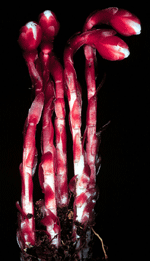James L. Luteyn and Paola Pedraza-Peñalosa
The New York Botanical Garden
|
|
Monotropa (Ericaceae: Monotropoideae) is a genus of two species with a broad boreal and a smaller disjunct neotropical distribution. The subfamily to which Monotropa belongs is composed of herbs which lack chlorophyll, all species having an obligate mycotrophic habit in which they appear to be indirectly parasitic on coniferous or fagaceous hosts by means of mycorrhizal fungi common to host and parasite. They are also characterized by pollen in monads. For more information about the subfamily and its relationships, see the various papers by Wallace (1975a,b, 1977, 1995a,b,c). |
MONOTROPA Linnaeus, Sp. pl. 1: 387. 1753. -- Lectotype: Monotropa uniflora Linnaeus.
[Hypopitys J. Hill, Brit. herb. 221. 1756, nom. illeg. Hypopithys Scopoli, Fl. carniol. ed. 2, vol. 1: 285. 1771, nom. illeg. (orthographic variant). Hypopithis Rafinesque, Medical Repository of New York, ser. 3, 1: 297. 1810, nom. illeg. (orthographic variant).]Monotropion Saint-Lager, Ann. Soc. Bot. de Lyon 7: 130. 1880.
Plants without chlorophyll, mycotrophic,
to 30 cm tall. Roots shallow, forming an open system along which
are often found more dense clumps of branched roots; ultimate branch
segments usually free for a short distance.
Inflorescences nodding, racemose or reduced to a solitary flower;
bracts present, sometimes similar to perianth; bracteoles present
in some specimens of M. hypopitys. Flowers nodding at anthesis,
becoming erect in fruit, more or less fleshy, (3-) 4-5 (-6)-merous;
calyx similar to corolla, quite distinct or apparently absent, similar
or not in color to corolla, glabrous or sparsely glandular pubescent, color
ranging from white to yellowish, orange or pink shades; corolla cylindrical,
or slightly flared distally, polypetalous, imbricate in bud, petals saccate
at base, often pubescent on inner surface, apices acute to truncate, color
ranging from white to yellowish, orange or pink
shades; stamens 8-10, generally twice as many as corolla lobes,
in two series of alternating lengths, included, color similar to corolla,
no appendages; anthers with connate sacs in a horizontal plane or
erect and hippocrepiform, smooth, lacking appendages or rarely awned, and
disintegration tissue, dehiscence terminal; pollen lacking viscin
threads, shed singly; ovary superior, usually pubescent, 5 (4-6)
locular, placentation axile; nectary present as 8-10 lobes projecting
basipetally from between staminal bases, paired opposite the saccate
bases of the petals; style cylindric, slender or stout, elongate
or short, included, conspicuously articulated with ovary; stigma
umbilicate to deeply funnelform, with 4-6 shallow lobes, glabrous or with
a dense ring of subtending
hairs. Fruit a loculicidal capsule, opening from apex to base,
pedicels erect at maturity, capsular segments persistent or irregularly
deciduous, vascular bundles between separated capsular segments may persist
in fruit linked by several lateral smaller vascular bundles; seeds
spindle-shaped, minute, 0.5-1 mm long, light brownish; embryo two-celled.
Chromosome numbers: n=24 or 2n=32; M. hypopitys 2n=ca.
48.
Key to Neotropical Species Back to Top
1. Inflorescences with several flowers, rarely reduced to a single
flower; sepals distinct
from petals; petals narrowly saccate
at base; anthers hippocrepiform, erect at
anthesis, dehiscence by a single terminal
slit; stigma only slightly funnelform, often
subtended by ring of stiff hairs; style
slender; lobes of nectary short and stout;
capsular segments thin, often deciduous late
in season; inflorescences ranging from
light yellow to reddish at anthesis, drying
brownish (Mexico, Guatemala)....... M.
hypopitys.
1. Inflorescences never more than a single flower; sepals
often similar to petals;
petals broadly saccate at base; anthers
not hippocrepiform, horizontal at anthesis,
dehiscence by slit open at its ends or along
its length; stigma conspicuously
funnelform, not subtended by a ring of stiff
hairs; style stout; lobes of nectary
elongate and slender; capsular segments
thick, often persisting until following season;
inflorescence ranging from white to orange-red
or combinations of these, drying black
(Mexico to C. Colombia).............................................................................. M. uniflora.
This is a version of the taxonomic treatment of the neotropical species of Monotropa (Ericaceae) by Gary D. Wallace, from "Ericaceae--Part II. The Superior-Ovaried Genera (Monotropoideae, Pyroloideae, Rhododendroideae, and Vaccinioideae p.p.)." The full treatment including specimen citations may be see in Flora Neotropica Monograph 66: 13-27 (Wallace, 1995b). This is published with permission of The New York Botanical Garden and Gary D. Wallace.
